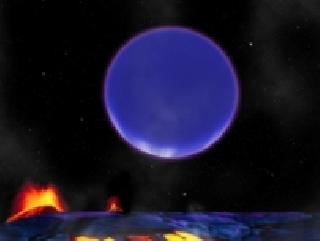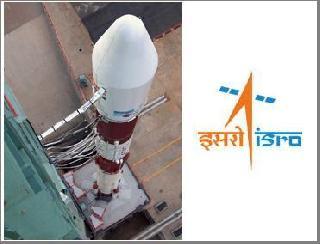
An artist's conception shows Kepler-36c as it might look from the surface of neighbouring Kepler-36b. A Harvard-Smithsonian Center for Astrophysics/David Aguilar photo
CAMBRIDGE (BNS): A giant gas planet, spanning in the sky three times the size of our Moon and rising over the molten landscape of a neighbouring rocky planet, has caught the attention and imagination of astronomers.
The new discovery, made by NASA's Kepler spacecraft, throws light on a twin planetary system, Kepler-36, in which the two neighbouring planets with dissimilar densities are orbiting very close to each other - the closest-spaced orbit ever confirmed in any planetary system to date.
"These two worlds are having close encounters," according to Josh Carter, a Hubble Fellow at the Harvard-Smithsonian Center for Astrophysics (CfA).
"They are the closest to each other of any planetary system we've found," says co-author Eric Agol of the University of Washington.
The twin planets - Kepler-36b and Kepler-36c - are too close to their host star which is a subgiant star much like the Sun except several billion years older. It is located 1,200 light-years from Earth.
The inner planet in the system, Kepler-36b, is a rocky world 1.5 times the size of Earth and weighs 4.5 times as much. It circles the host star about every 14 days at an average distance of less than 11 million miles.
The outer world, Kepler-36c, is a gaseous planet 3.7 times the size of Earth and weighs 8 times as much. This "hot Neptune" orbits the star once each 16 days at a distance of 12 million miles.
The two planets experience a conjunction every 97 days on average. At that time, they are separated by less than 5 Earth-Moon distances.
Since Kepler-36c is much larger than the Moon, it presents a spectacular view in its neighbour's sky. Such close approaches stir up tremendous gravitational tides that squeeze and stretch both planets, according to the astronomers who have made the discovery.
What is puzzling the team of astronomers is the presence of these two very different planets in such close orbits.
Within our Solar System, rocky planets reside close to the Sun while the gas giants remain distant.
Although Kepler-36 is the first planetary system found to experience such close encounters, it undoubtedly won't be the last, believe the researchers.
"We're wondering how many more like this are out there," said Agol.
"We found this one on a first quick look," added Carter. "We're now combing through the Kepler data to try to locate more."
The researchers present their findings in Science Express.
 Previous Article
Previous Article Next Article
Next Article













The Indian Air Force, in its flight trials evaluation report submitted before the Defence Ministry l..
view articleAn insight into the Medium Multi-Role Combat Aircraft competition...
view articleSky enthusiasts can now spot the International Space Station (ISS) commanded by Indian-American astr..
view article